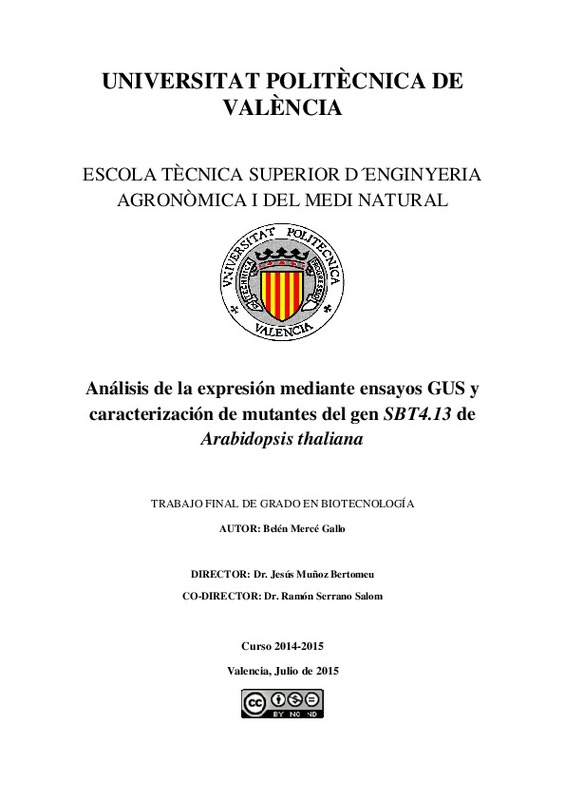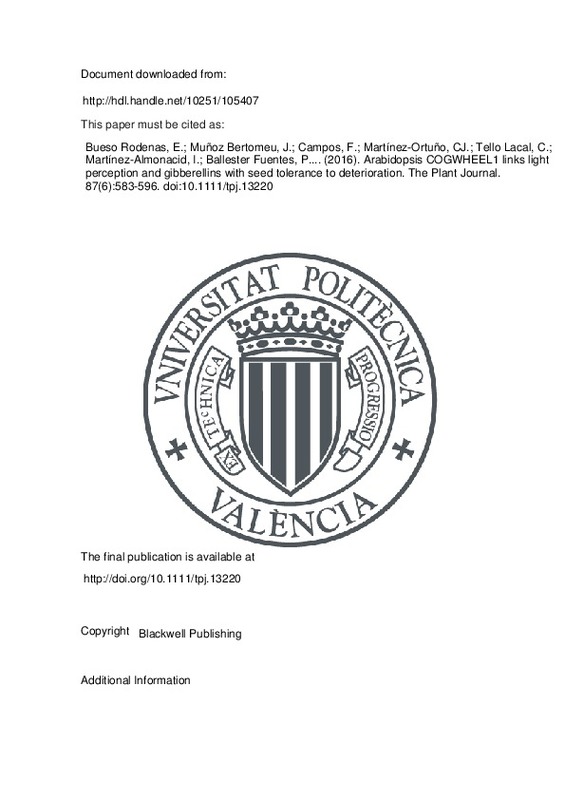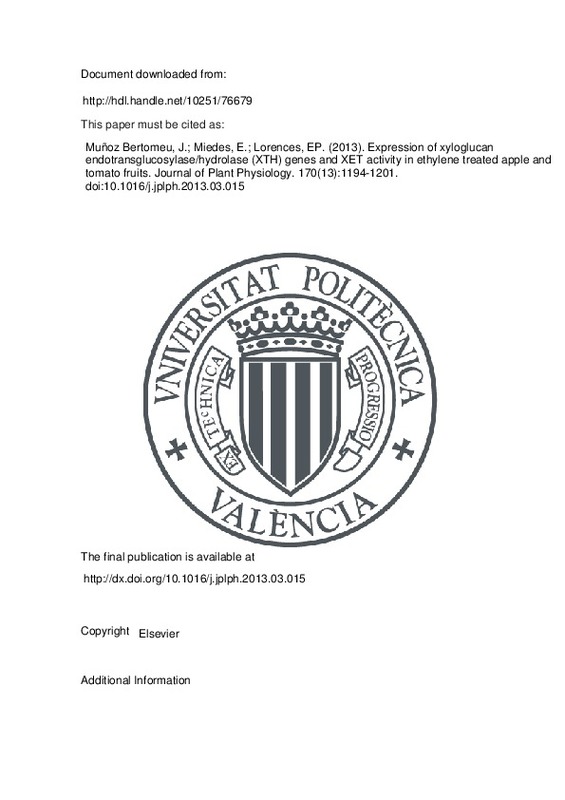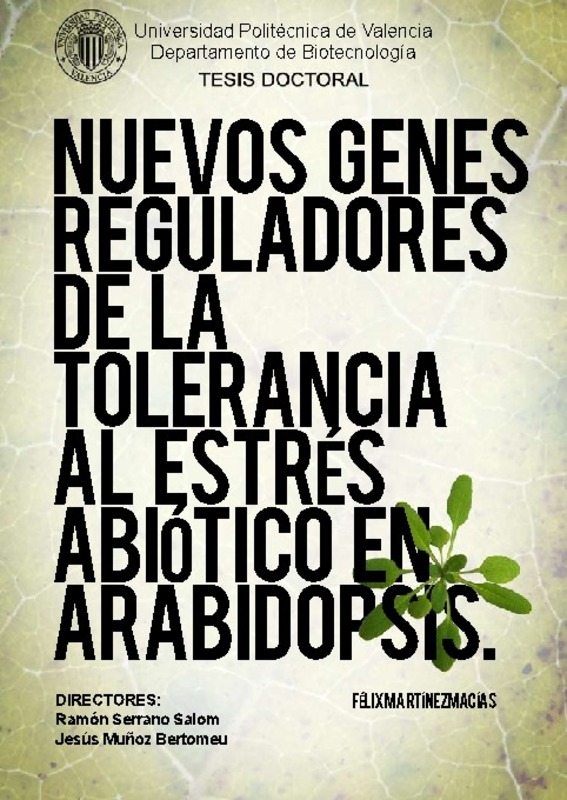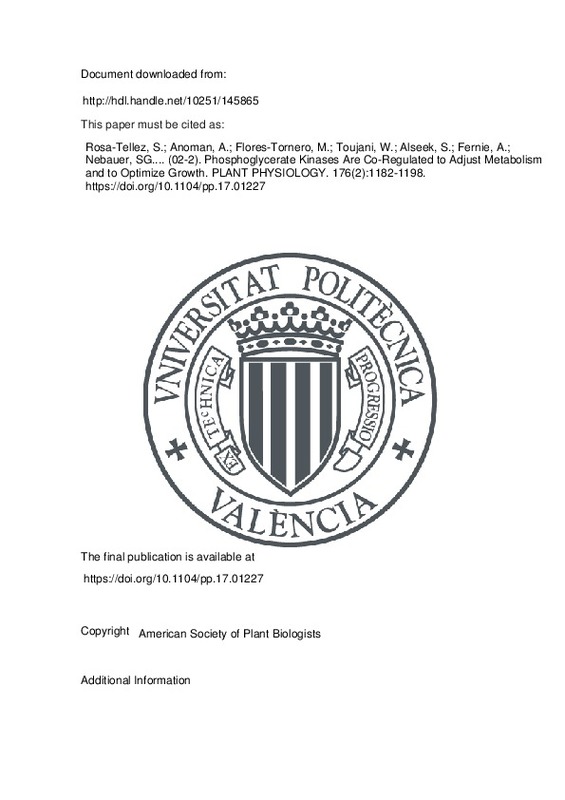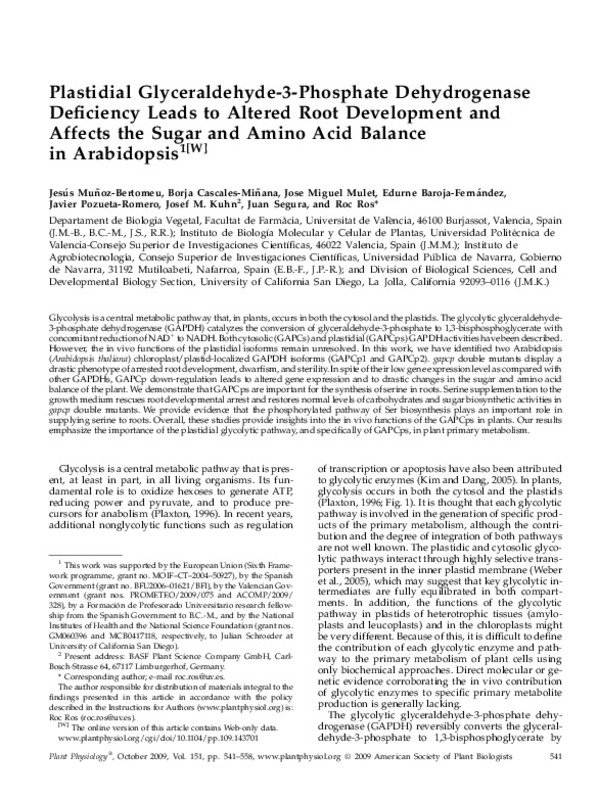

Listar por autor "Muñoz Bertomeu, Jesús"
RiuNet: Repositorio Institucional de la Universidad Politécnica de Valencia
- RiuNet repositorio UPV
- :
- Listar por autor
JavaScript is disabled for your browser. Some features of this site may not work without it.
Buscar en RiuNet
Listar
Mi cuenta
Ayuda RiuNet
Admin. UPV
Listar por autor "Muñoz Bertomeu, Jesús"
Mostrando ítems 1-20 de 25
-
Bueso Ródenas, Eduardo; Ibanez, Carla; Sayas, Enric; Muñoz Bertomeu, Jesús; González Guzmán, Miguel; Rodríguez Egea, Pedro Luís; Serrano Salom, Ramón (Elsevier, 2014-02)[EN] Seed longevity is important to preserve crops and wild plants and it is limited by progressive cellular damage (aging) during storage. The induction of cellular stress defenses and the formation of the seed coat are ...
-
Martínez Macías, Félix; Arif, Anjuman; González Nebauer, Sergio; Bueso Ródenas, Eduardo; Ali, Rashid; Montesinos De Lago, Consuelo; Brunaud, Veronique; Muñoz Bertomeu, Jesús; Serrano Salom, Ramón (Springer Verlag (Germany), 2015)[EN] A fungal gene encoding a transcription factor is expressed from its own promoter in Arabidopsis phloem and improves drought tolerance by reducing transpiration and increasing osmotic potential. Horizontal gene ...
-
Mercé Gallo, Belén (Universitat Politècnica de València, 2015-09-07)[EN] By screening collections of mutants with transcriptional activation, an Arabidopsis mutant tolerant to intracellular acid stress during germination was identified. After the mapping of the insertion site and expression ...
-
Simón Moya, Miguel (Universitat Politècnica de València, 2016-12-14)[EN] This work tries to elucidate the possible relationship between NGATHA and TRANSMITTING NO TRACT genes in relation to the development transmitting tract and regulation of genes that determine the formation of the ...
-
Arabidopsis COGWHEEL1 links light perception and gibberellins with seed tolerance to deterioration Bueso Ródenas, Eduardo; Muñoz Bertomeu, Jesús; Campos, Francisco; Martínez-Ortuño, Cándido José; Tello Lacal, Carlos; Martínez-Almonacid, Irene; Ballester Fuentes, Patricia; Simon-Moya, Miguel; Brunaud, Veronique; Yenush, Lynne; Ferrandiz Maestre, Cristina; Serrano Salom, Ramón (Blackwell Publishing, 2016)[ES] Significance Statement Seed tolerance to deterioration depends on anti-aging defenses only partially understood. COG1 encodes a transcription factor previously described to attenuate phytochrome responses to light and ...
-
Bueso Ródenas, Eduardo; Muñoz Bertomeu, Jesús; Campos, Francisco; Brunaud, Veronique; Martinez, Liliam; Sayas Montañana, Enric Miquel; Ballester Fuentes, Patricia; Yenush, Lynne; Serrano Salom, Ramón (American Society of Plant Biologists, 2014-02)[EN] Seed longevity is crucial for agriculture and plant genetic diversity, but it is limited by cellular damage during storage. Seeds are protected against aging by cellular defenses and by structures such as the seed ...
-
Muñoz Bertomeu, Jesús; Lorences, E.P. (Springer Verlag (Germany), 2014-02)Although the plant cell wall is an extremely effective physical barrier against attack by pathogens, most phytopathogenic microorganisms produce enzymes that are capable of degrading cell wall polymers such as pectin and ...
-
Mendoza-Poudereux, Isabel; Muñoz Bertomeu, Jesús; Arrillaga, Isabel; Segura, Juan (Elsevier, 2014)[EN] Spike lavender (Lavandula latifolia) is an economically important aromatic plant producing essential oils, whose components (mostly monoterpenes) are mainly synthesized through the plastidial methylerythritol 4-phosphate ...
-
Muñoz Bertomeu, Jesús; Arrillaga, Isabel; Segura, Juan (Elsevier, 2007-08)Essential oil yield and composition in seven natural populations of Lavandula latifolia from the eastern Iberian Peninsula were determined by GC/MS. Twenty-eight constituents were identified, accounting for 92.0e95.4% of ...
-
Muñoz Bertomeu, Jesús; Miedes, Eva; Lorences, E. P. (Elsevier, 2013-09-01)[EN] Xyloglucan endotransglucosylase/hydrolase (XTHs: EC 2.4.1.207 and/or EC 3.2.1.151), a xyloglucan modifying enzyme, has been proposed to have a role during tomato and apple fruit ripening by loosening the cell wall. ...
-
Martínez Macías, Félix (Universitat Politècnica de València, 2012-05-16)La salinidad es uno de los problemas ambientales con mayor impacto sobre la producción mundial de alimentos, especialmente en las zonas semiáridas, como puede ser el caso de la Comunidad Valenciana. Durante los últimos ...
-
Selgas Sanchis, Ignacio (Universitat Politècnica de València, 2014-09-26)[ EN ] Plants are immobile organisms that live in changing environments therefore have developed mechanisms to respond to all kinds of stresses including intracellular acid stress. PH homeostasis allows plant cells to ...
-
Montañana Navarro, Betlem (Universitat Politècnica de València, 2016-02-11)[EN] All the species along the evolution have developed diferents mechanisms to resist any changes in their environment. But the plants, to be sessile organisms , have had to develop many more tools of defense or adaptation ...
-
Toujani, Walid; Muñoz Bertomeu, Jesús; Flores-Tornero, María; Rosa-Tellez, Sara; Anoman, Armand Djoro; Ros, Roc (Taylor & Francis, 2013-11)[EN] Three different pathways of serine (Ser) biosynthesis have been described in plants: the Glycolate pathway, which is part of the Photorespiratory pathway, and 2 non-Photorespiratory pathways, the Glycerate and the ...
-
Muñoz Bertomeu, Jesús; Anoman, Armand Djoro; Toujani, Walid; Cascales-Miñana, Borja; Flores-Tornero, María; Ros, Roc (Taylor & Francis, 2011-01)[EN] The phytohormone abscisic acid (ABA) controls the development of plants and plays a crucial role in their response to adverse environmental conditions like salt and water stress.1-3 Complex interactions between ABA ...
-
Martínez Macías, Félix (Universitat Politècnica de València, 2015-03-31)
-
Casatejada-Anchel, Rubén; Muñoz-Bertomeu, Jesús; Rosa-Tellez, Sara; Anoman, Armand D.; Nebauer, Sergio G.; Torres-Moncho, Alejandro; Fernie, Alisdair R.; Ros, Roc (Elsevier, 2021-05)[EN] Unlike animals, plants possess diverse L-serine (Ser) biosynthetic pathways. One of them, the Phosphorylated Pathway of Serine Biosynthesis (PPSB) has been recently described as essential for embryo, pollen and root ...
-
Rosa-Tellez, S.; Anoman, A.D.; Flores-Tornero, M.; Toujani, W.; Alseek, S.; Fernie, A.; Nebauer, Sergio G.; Muñoz Bertomeu, Jesús; Segura, Juan; Ros Palau, Roc (American Society of Plant Biologists, 2018-02)[EN] In plants, phosphoglycerate kinase (PGK) converts 1,3-bisphosphoglycerate into 3-phosphoglycerate in glycolysis but also participates in the reverse reaction in gluconeogenesis and the Calvin-Benson cycle. In the ...
-
Muñoz Bertomeu, Jesús; Cascales Miñana, Borja; Mulet Salort, José Miguel; Baroja-Fernandez, Edurne; Pozueta Romero, Javier; Kuhn, Josef M.; Segura Garcia del Rio, Juan; Ros Palau, Roc (American Society of Plant Biologists, 2009-10)[EN] Glycolysis is a central metabolic pathway that, in plants, occurs in both the cytosol and the plastids. The glycolytic glyceraldehyde-3-phosphate dehydrogenase (GAPDH) catalyzes the conversion of glyceraldehyde-3-phosphate ...
-
Anoman, Armand D; Muñoz Bertomeu, Jesús; Rosa-Tellez, Sara; Flores-Tornero, María; Serrano Salom, Ramón; Bueso Ródenas, Eduardo; Fernie, Alisdair R; Segura, Juan; Ros Palau, Roc (American Society of Plant Biologists, 2015-11)This study functionally characterizes the Arabidopsis (Arabidopsis thaliana) plastidial glycolytic isoforms of glyceraldehyde-3-phosphate dehydrogenase (GAPCp) in photosynthetic and heterotrophic cells. We expressed the ...
Mostrando ítems 1-20 de 25

Universitat Politècnica de València. Unidad de Documentación Científica de la Biblioteca (+34) 96 387 70 85 · RiuNet@bib.upv.es



